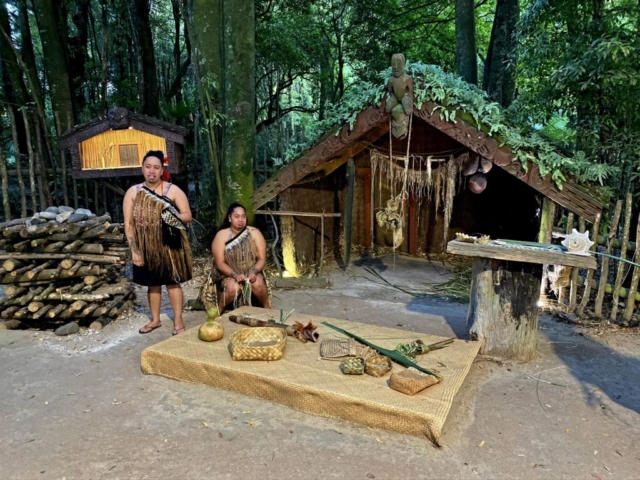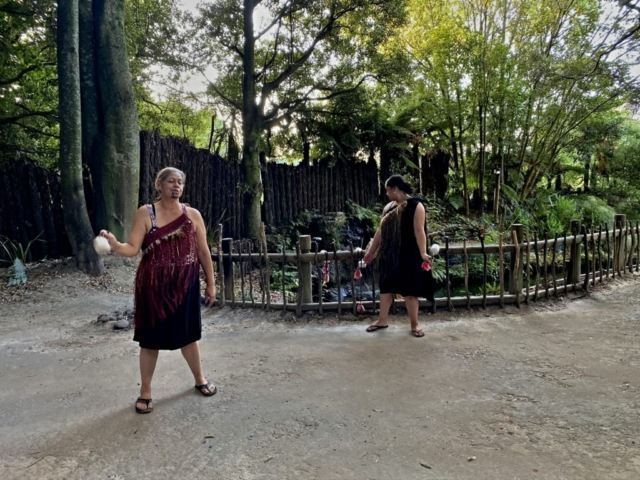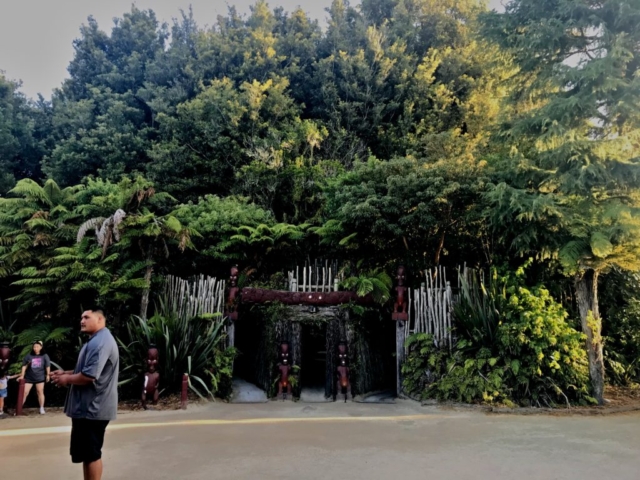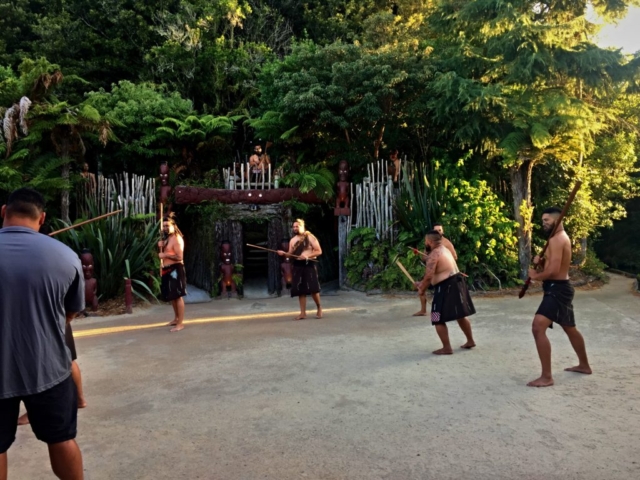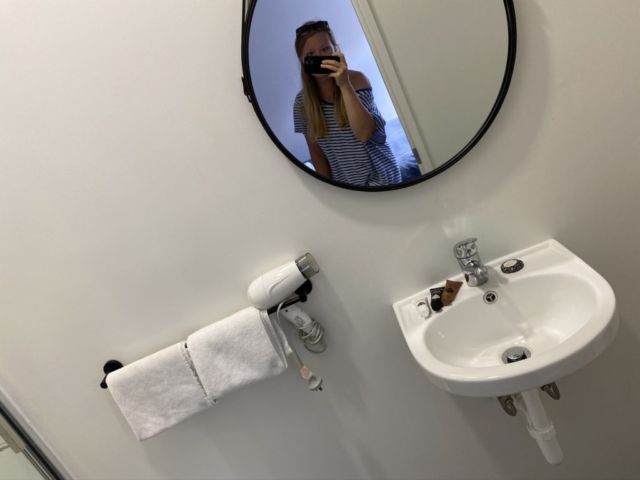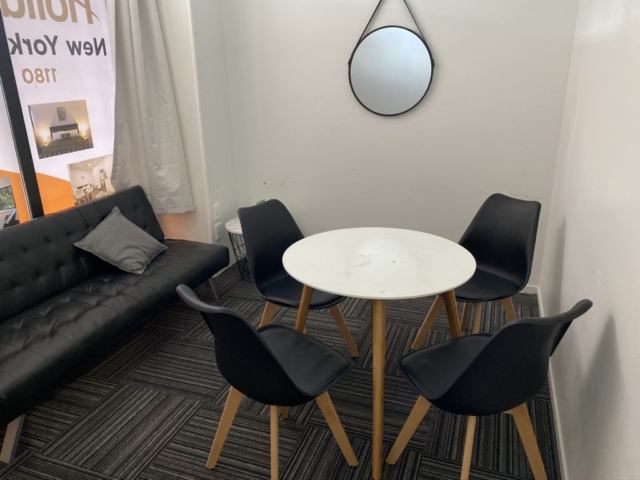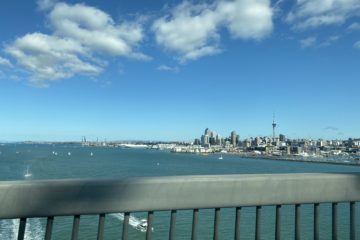Finally, I can write about the place I was most looking forward to. It was the most expensive item in terms of the admission price, but the experience was definitely worth it! On the other hand, what more can I wish in New Zealand than to see the Maori culture in a living Maori village that passes on all traditions to the next generations? On the other hand, the overcrowded and rushed Hobbiton created only thanks by filming the Lord of the Rings Trilogy can stab! Most people repeat that tourism and globalization are destroying the authentic beauty of each country, which is probably the main reason why I was so excited about this visit
And it would not be me if I booked not only a tour of the village but the whole evening program with a welcome ceremony, tour of the village with commentary at each location, with dance, singing and dinner.
Tamaki Maori Village
In 1989 it all started. Doug and Mike Tamaki have forever changed the way people around the world experience cultural narration. Now 30 years later, Tamaki Maori Village has become an iconic brand in tourism and is the most recognized cultural attraction in New Zealand. In 2018, she won the Traveller’s Choice Award for the 7th Best Experience in the World.
In the heart of the village there are 3 main points:
- Mana Whenua (Country)
- Mana Tangata (People)
- Mana Atua (Faith)
Maori culture
Includes habits, cultural practices and beliefs of indigenous people in New Zealand. It originates and is still a part of Eastern Polynesian culture. The word Māoritanga is often used as a synonym for Maori culture. In modern times, Māoritanga has been influenced by increasing urbanization and closer contact with New Zealanders of European origin (or Pākehā).
Traditional art Māori plays a major role in New Zealand art. These include whakairo (carving), raranga (weaving), kapa haka (group ceremony), whaikōrero (oratorio) and tā moko (tattoo). The patterns and figures represented record the Maori faith and genealogy (whakapapa). They often follow the techniques of their ancestors, but in the 21st century, Māoritanga also includes contemporary art such as film, television, poetry and theatre.
The Maori language is known as Te Reo Māori, abbreviated as Te Reo (literally “language”). At the beginning of the twentieth century, like other aspects of Maori life, their language will disappear, but thanks to government support in the 1980s, the Maori language began to be taught in schools.
History of Maori culture
The cultural history of the Maori is inextricably linked to the culture of Polynesia. New Zealand is the southwestern corner of the Polynesian Triangle in the Pacific Ocean. The triangle includes the Hawaiian Islands, Easter Islands (Rapa Nui) and New Zealand (Aotearoa). It shares similar languages, religions, social organizations, myths and material culture.
The Polynesians travelled the sea long distances and the presence of women in large numbers was not accidental but intentional. The latest reliable evidence suggests that New Zealand’s settlement occurred around 1280 AD. In 1769, an experienced navigator Tupaia joined Captain Cook in Endeavor. Tupaia could understand the Maori language because it was very similar to the language he spoke. His presence and the ability to translate were of great importance in the contact of Europeans with the indigenous Maori in New Zealand.
Cultural concepts
Some of the basic cultural concepts of Māoritanga are present throughout Polynesia, but all have been altered by New Zealand’s unique history and environment.
Mana (power and prestige)
Mana means sacred power or authority that is granted by gods on the lineage of the chiefs, or Tohunga. While Mana itself is a supernatural gift, the chief may lose or enlarge it.
Whakapapa (genealogy)
Whakapapa is the origin of a person, object or geographical area. Whakapapa of person creates his Manu and tribal relationships.
Utu (balance and harmony)
Utu is often associated with the word “revenge”. In a broader sense, however, Utu is meant to maintain balance and harmony in civilization. The error must always be corrected and the favour returned. However, the means may vary considerably from case to case. As part of the exchange of gifts, Utu creates and maintains social ties and commitments.
The exchange of gifts followed three basic principles:
- Donations must be free and spontaneous.
- There is a strict obligation system under which the beneficiary was obliged to increase the value of the gift.
- The system requires that additional social commitments be introduced that will continue to exchange donations.
Failure to respond meant loss of Manu or influence. While the gift meant an obligation to return the kindness, the same vengeance applied to the insult and could mean a fight.
Kaitiakitanga
It means guardianship or protection, and in modern use, it is mostly concerned with protecting the natural environment.
Tapu (forbidden and sacred)
Tapu is similar to Mana. Together they maintain the harmony of things. Tapu maintains the structure and social order. This can be seen as a legal or religious concept that focuses on the idea of “forbid” and “sanctify”. When a person, place or thing is considered Tapa, it is often characterized as something of high value and significance.
Kaumātua (Council of Elders)
Kaumātua is a respected tribal council of the elderly (both sexes) in the Maori community. They are appointed by their people who believe that elected elders have the ability to teach and lead present and future generations.
Kōhā (gifts)
Kōhās are gifts to the hosts (formerly food or traditional objects, but nowadays money is often given). The essence of Kōhā is that it is voluntary and comes from the heart, so the determination of the amount is contrary to his spirit. Beneficiaries rely on donor´s arohu (empathy), manaakitang (caring) and wairua (spirit).
Matariki (New Year)
Matariki, the Maori New Year, celebrates the Pleiades’ first rise in late May or early June. It is a day of paying homage to people who have lost but also gained in the last year that has passed. They celebrate day and night with prayers, feasting, singing and music.
Toi whakairo (carving)
Maori traditional art in wood, stone or bone. Wood was carved in houses, fences, etc. Stone, preferably very hard Pounamu (greenstone), was the main material for tools of all kinds. Bones were used for fish hooks, needles, etc.
The pre-European stories and legends of the Maori were transmitted orally, by weaving and carvings. Some surviving whakairo or carvings are over 500 years old. Tohunga whakairo is masters in their field. Carving is the art of Tapu and is therefore subject to its rules and laws.
The Māori Arts and Crafts Institute in Whakarewarewa, Rotorua is a fortress of traditional carving skills. Hone Taiapa has been the head of this school for some time.
Weaving (raranga) and traditional clothing
Before European colonization, the Maori wore clothing (weather protection and social status). They wore 2 main garments: a skirt worn around the waist secured with a belt and a cloak worn over the shoulders. The coats (korowai) were symbols of high rank.
Textiles were made from a variety of plants, including harakeke (flax from New Zealand), wharariki, tī kōuka, tōī, pīngao, kiekie and toetoe. Raw flax leaves were split and woven into mats, ropes and nets, but prepared flax fiber (muka) became the basis of most garments.
Compared to European clothing, it took a long time to produce traditional clothing and did not offer much protection from changing weather. The Maori thus adopted European clothing, which soon became widely available. Since the end of the 19th century, traditional clothing has only been used on festive occasions.
Tattoos (tā moko)
Tā moko is a traditional skin tattoo. Before colonization, most high-ranking people adopted tā moko as an important milestone between childhood and adulthood, and those who left without them were perceived as less social. Art was a sacred activity, accompanied by many rituals and ceremonies. Men usually received tā moko on cheeks, buttocks and thighs, women on lips and chin. The tattoo details the pedigree, the condition and the origin of the wearer.
Kapa Haka
Kapa haka literally means “group” (kapa) and “dance” (haka). Through song and dance, they express and showcase their heritage and cultural Polynesian identity. The performance includes choral singing, dance and direct combat movements.
Types of music and dance are waiata tira (warm-up song), whakaeke (entry song), waiata-ā-ringa (action song), haka (challenge), pou or mōeatea (old-style singing), poi (coordinated swinging of balls attached to strings) and whakawātea (the final song). They may also include tītī tōrea (synchronized handling of thin rods). At full performance, which can last up to 40 minutes, each type of music or dance can appear more than once.
Music for kapa haka is primarily vocal. All types of songs, with the notable exceptions of mōeatea and haka, are structured according to the harmony of the European style, often accompanied by guitar and acoustics. The songs involve the spurs of the Haka-style declaration, as well as dance moves, facial expressions, and other body and auditory signals that are unique to the Maori.
The only musical instruments used in kapa haka are guitar, pūtatara conch, poi and rākau sounds, and body percussion, especially foot pressing.
Haka
Haka are described as challenges and traditional war dances. Men are at the forefront and women are supporting them. It is a vocal performance involving rhythmic declamations and aggressive facial expressions (pūkana, literally “glaring”), body movements and behaviour. Men intensively use foot ramming, body impact and grimace to look menacing. Now, this dance is regularly performed by representatives of New Zealand rugby teams before the game starts.
Poi
Poi is female dances involving ball swinging, the size of tennis balls attached to cords. Today, Poi is used to showcase the beauty and grace of women. Performers swing the balls synchronously in different positions and rhythms while singing a song (waiata poi). They show great agility and coordination. The sound of Poi when it hits your hands is an important part of the music.
Tītī tōrea
Tītī tōrea are pairs of carved thin sticks with shoulder widths. Similarly to Poi, tītī tōreas move synchronously and with music.
Marae
Marae is a place where meetings and ceremonies are held in accordance with traditional protocols. It symbolizes the unity of the group and consists of an open, cleared area in front of a large carved meeting house. There are formal welcomes, celebrations, weddings, christenings, reunions and tangihanga (funerals).
Hui or meeting
It starts with pōwhiri (welcome ceremony). The visitor is greeted by the aggressive challenge of a warrior armed with a taiah (traditional battlegroup), who then offers the visitor a sign of peace, such as a fern. Acceptance of fern in the face of aggression is a manifestation of courage and Mana of the visitor. Pōwhiri is highly structured and traditionally formatted.
Religion
The Maori traditional religion has hardly deviated from its Polynesian roots. Accordingly, all things were considered to have vital forces. The god Tangaroa was the personification of the ocean and the ancestor of all fish, Tāne was the personification of the forest and the ancestor of all birds, and Rongo was the personification of peaceful activities, agriculture and the ancestor of cultivated plants.
Traditional cuisine (Kai)
When native people arrived in New Zealand from tropical Polynesia, they brought a variety of plant foods, including kumara (sweet potatoes), tara, uwhi, hue and tī-pore. Most of these plants grew well only in the north of the North Island. Kumara, on the other hand, could be grown everywhere, stored in winter, and thus became the main food of all inhabitants. New Zealand plants, such as fern, have become an important part of the diet, along with insects such as huhu grub or earthworms called noke.
Food was cooked in ovens underground (known as hāngi or umu). The stones were heated by fire, and food was wrapped in leaves and put on stones. Other cooking methods were steaming in geothermal areas using natural hot springs and pools.
Maori people are one of the few people who have no form of traditional alcoholic beverage.
Today’s Maori cuisine is a blend of traditional Maori cuisine, old-fashioned English cooking and contemporary dishes. The two dishes that are considered traditional Maori nowadays are roasted pork with potatoes, kumara and dumplings, and pork and a thigh (pig thistle). Also important is réwena, or “Maori bread”, which is made from fermented potatoes.
Our accommodation
After meeting with the indigenous Maori people and learning about Maori culture we will be on our way to the town of Paeroa, but we are planning several stops along the way 🙂














